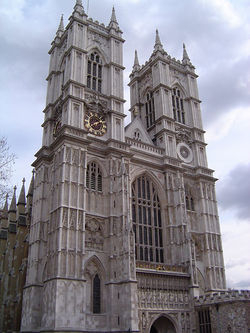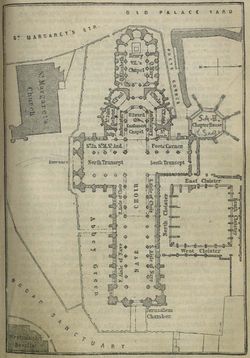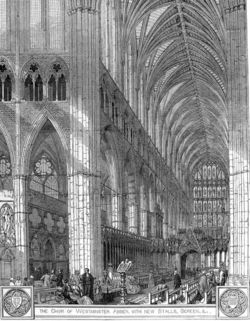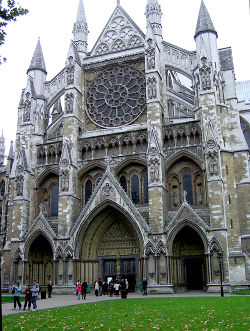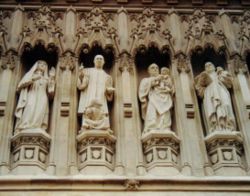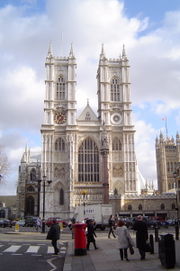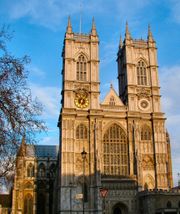Westminster Abbey
2007 Schools Wikipedia Selection. Related subjects: Architecture
The Collegiate Church of St Peter, Westminster, which is almost always referred to as Westminster Abbey, is a mainly Gothic church, on the scale of a cathedral (and indeed often considered one), in Westminster, London, just to the west of the Palace of Westminster. It is the traditional place of coronation and burial site for English monarchs.
History
According to tradition a shrine was first founded in 616 on the present site, then known as Thorn Ey (Thorn Island); its tradition of miraculous consecration after a fisherman on the River Thames saw a vision of Saint Peter justified the presents of salmon from the Thames fishermen that the Abbey received. In the 960s or early 970s Saint Dunstan, assisted by King Edgar planted a community of Benedictine monks here. The stone Abbey was built around 1045– 1050 by King Edward the Confessor, who had selected the site for his burial: it was consecrated on December 28, 1065, immediately before the Confessor's funeral. It was the site of the last Saxon coronation of his successor King Harold.
The only extant depiction of the original Abbey, in the Romanesque style that is called "Norman" in England, together with the adjacent Palace of Westminster, is in the Bayeux Tapestry. Increased endowments supported a community increased from Dunstan's dozen to about eighty monks (Harvey 1993 p 2).
The Abbot and learned monks, in close proximity to the royal Palace of Westminster, the seat of government from the later twelfth century, became a powerful force in the centuries after the Norman Conquest: the Abbot was often employed on royal service and in due course took his place in the House of Lords as of right. Released from the burdens of spiritual leadership, which passed to the reformed Cluniac movement after the mid-tenth century, and occupied with the administration of great landed properties, some of which lay far from Westminster, "the Benedictines achieved a remarkable degree of identification with the secular life of their times, and particularly with upper-class life", Barbara Harvey concluded, to the extent that her depiction of daily life (Harvey 1993) provides a wider view of the concerns of the English gentry in the High and Late Middle Ages. The proximity of the Palace of Westminster did not extend to providing monks or abbots with high royal connections; in social origin the Benedictines of Westminster were as modest as most of the order. The abbot remained lord of the manor of Westminster as a town of two to three thousand persons grew around it: as a consumer and employer on a grand scale the monastery helped fuel the town economy, and relations with the town remained unusually cordial, but no enfranchising charter was issued during the Middle Ages (Harvey 1993 p 6f). The abbey built shops and dwellings on the west side, encroaching upon the sanctuary.
The Abbey became the coronation site of Norman kings, but none were buried there until Henry III, intensely devoted to the cult of the Confessor, rebuilt the Abbey in Anglo-French Gothic style as a shrine to honour Edward the Confessor and as a suitably regal setting for Henry's own tomb, under the highest Gothic nave in England. The Confessor's shrine subsequently played a great part in his canonisation. The work continued between 1245- 1517 and was largely finished by the architect Henry Yevele in the reign of King Richard II. Henry VII added a Perpendicular style chapel dedicated to the Virgin Mary in 1503 (known as the Henry VII Chapel). Much of the stone came from Caen, in France ( Caen stone), the Isle of Portland ( Portland stone) and the Loire Valley region of France ( tuffeau limestone).
In 1535, the Abbey's annual income of £2400-2800 during the assessment attendant on the Dissolution of the Monasteries rendered it second in wealth only to Glastonbury Abbey. Henry VIII had assumed direct royal control in 1539 and granted the Abbey cathedral status by charter in 1540, simultaneously issuing letters patent establishing the diocese of Westminster. By granting the Abbey cathedral status Henry VIII gained an excuse to spare it from the destruction or dissolution which he inflicted on most English abbeys during this period. Westminster was a cathedral only until 1550. The expression "robbing Peter to pay Paul" may arise from this period when money meant for the Abbey, which was dedicated to St Peter, was diverted to the treasury of St Paul's Cathedral.
The Abbey was restored to the Benedictines under the Catholic Queen Mary, but they were again ejected under Queen Elizabeth I in 1559. In 1579, Elizabeth re-established Westminster as a " Royal Peculiar" — a church responsible directly to the sovereign, rather than to a diocesan bishop — and made it the Collegiate Church of St Peter, (that is a church with an attached chapter of canons, headed by a dean). The last Abbot was made the first Dean. It suffered damage during the turbulent 1640s, when it was attacked by Puritan iconoclasts, but was again protected by its close ties to the state during the Commonwealth period. Oliver Cromwell was given an elaborate funeral there in 1658, only to be disinterred in January 1661 and posthumously hanged from a nearby gibbet.
The abbey's two western towers were built between 1722 and 1745 by Nicholas Hawksmoor, constructed from Portland stone to an early example of a Gothic Revival design. Further rebuilding and restoration occurred in the 19th century under Sir George Gilbert Scott.
Until the 19th century, Westminster was the third seat of learning in England, after Oxford and Cambridge. It was here that the first third of the King James Bible Old Testament and the last half of the New Testament were translated. The New English Bible was also put together here in the 20th century.
Coronations
Since the coronations in 1066 of both King Harold and William the Conqueror, all English and British monarchs (except Lady Jane Grey - although it is highly debatable whether she was, either in theory or practice, the Queen of England - Edward V and Edward VIII, who did not have coronations) have been crowned in the Abbey. The Archbishop of Canterbury is the traditional cleric in the coronation ceremony. St Edward's Chair, the throne on which British sovereigns are seated at the moment of coronation, is housed within the Abbey; from 1296 to 1996 the chair also housed the Stone of Scone upon which the kings of Scotland are crowned, but pending another coronation the Stone is now kept in Scotland.
According to H.V. Morton's In Search of London, a ghostly monk is said to appear in the Abbey on the eve of a monarch's coronation. The book states that the monk was last seen prior to the coronation of George VI in 1937. (The book was published in 1951; it is unknown if the monk was seen prior to Queen Elizabeth II's coronation in 1953.)
Burials and Memorials
Henry III rebuilt the Abbey in honour of the Royal Saint Edward the Confessor whose relics were placed in a shrine in the sanctuary. Henry III was interred nearby in a superb chest tomb with effigial monument, as were many of the Plantagenet kings of England, their wives and other relatives. Subsequently, most Kings and Queens of England were buried here, although Henry VIII and Charles I are buried at St George's Chapel, Windsor Castle, as are all monarchs and royals after George II.
In 2005 the original ancient burial tomb of Edward the Confessor was discovered, beneath the 1268 Cosmati mosaic pavement, in front of the High Altar. A series of royal tombs dating back to the 13th and 14th centuries was also discovered using ground-penetrating radar.
Aristocrats were buried in side chapels and monks and people associated with the Abbey were buried in the Cloisters and other areas. One of these was Geoffrey Chaucer, who was buried here as he had apartments in the Abbey where he was employed as master of the Kings Works. Other poets were buried around Chaucer in what became known as Poets' Corner. Abbey musicians such as Henry Purcell were also buried in their place of work. Subsequently it became an honour to be buried or memorialised here. The practice spread from aristocrats and poets to generals, admirals, politicians, scientists, doctors, etc., etc. These include:
Buried
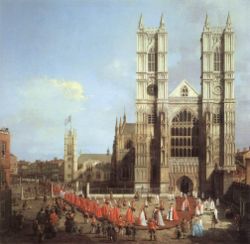
Nave
- Clement Attlee, 1st Earl Attlee
- Angela Georgina Burdett-Coutts
- Thomas Cochrane, 10th Earl of Dundonald
- Charles Darwin
- Saint Edward the Confessor
- George Graham
- Ben Jonson
- David Livingstone
- James Clerk Maxwell
- Sir Isaac Newton
- Ernest Rutherford, 1st Baron Rutherford
- Robert Stephenson
- Ludovic Stewart, 2nd Duke of Lennox
- J.J. Thomson
- William Thomson, 1st Baron Kelvin
- Thomas Tompion
- The Unknown Warrior
- George Villiers, 1st Duke of Buckingham
- Charles Lyell
North Transept
- William Ewart Gladstone
- William Pitt, 1st Earl of Chatham
- William Pitt the Younger
South Transept
Poets' Corner
- Robert Adam
- Robert Browning
- William Camden
- Thomas Campbell
- Geoffrey Chaucer
- William Congreve
- Abraham Cowley
- William Davenant
- Charles Dickens
- John Dryden
- Adam Fox
- David Garrick
- John Gay
- George Frederick Handel
- Thomas Hardy
- Dr Samuel Johnson
- Rudyard Kipling
- Thomas Macaulay
- John Masefield
- Laurence Olivier, Baron Olivier
- Thomas Parr
- Dante Rossetti
- Richard Brinsley Sheridan
- Edmund Spenser
- Alfred Tennyson, 1st Baron Tennyson
Cloisters
- Aphra Behn
- Percy Dearmer
- General John Burgoyne
North Choir Aisle
- Henry Purcell
- Ralph Vaughan Williams
Chapel of St Paul
- Sir Rowland Hill
Commemorated
- William Shakespeare, buried at Stratford-upon-Avon
- Sir Winston Churchill, buried at Bladon, Oxfordshire
- Benjamin Disraeli, 1st Earl of Beaconsfield, buried at Hughenden Manor, Buckinghamshire
- Adam Lindsay Gordon, buried in Australia
- Lord Baden-Powell, buried in Nyeri, Kenya
- Paul Dirac, buried in Florida
- Oscar Wilde (in a stained glass window unveiled in 1995), buried in Paris
- Henry Wadsworth Longfellow, buried at Cambridge, Massachusetts
- General James Wolfe
- Ten 20th-century Christian martyrs from across the world are depicted in statues above the Great West Door. Unveiled in 1998 by Her Majesty The Queen, these are, from left to right:
- St. Maximilian Kolbe
- Manche Masemola
- Janani Luwum
- Grand Duchess Elizabeth of Russia
- Martin Luther King, Jr.
- Óscar Romero
- Dietrich Bonhoeffer
- Esther John
- Lucian Tapiedi
- Wang Zhiming
Removed
The following were buried in the abbey but later removed on the orders of Charles II:
- Oliver Cromwell, Lord Protector
- Admiral Robert Blake
- John Pym
Schools
Westminster School and Westminster Abbey Choir School are also in the precincts of the Abbey. It was natural for the learned and literate monks to be entrusted with education, and Benedictine monks were required by the Pope to maintain a charity school in 1179; Westminster School may have been founded even earlier for children or novices, and the legendary Croyland Chronicle relates a story of 11th century king Edward the Confessor's Queen Editha chatting to a schoolboy in the cloisters, and sending him off to the Palace larder for a treat.
Transport
- Nearest London Underground stations:
- St. James's Park (District, Circle lines)
- Westminster (Jubilee, District, Circle lines)
Chapter
The Abbey is a collegiate church organised into the College of St Peter, which comprises the Dean and four residentiary Canons (one of whom is also Rector of St Margaret's Church, Westminster, and Speaker's Chaplain), and seventeen other persons who are members ex officio, as well as twelve lay vicars and ten choristers. The seventeen are the Receiver-General and Chapter Clerk, the Registrar, the Auditor, the Legal Secretary and the Clerk of the Works (the administrative officers). Those more directly concerned with liturgical and ceremonial operations include the Precentor, the Chaplain and Sacrist, the Organist, and the (honorary) High Steward and High Bailiff. The Abbey and its property is in the care of the Librarian, the Keeper of the Muniments, and the Surveyor of the Fabric. Lastly, the educational role of the Abbey is reflected in the presence of the Headmaster of the Choir School, the Headmaster and Under Master of Westminster School, and the Master of The Queen's Scholars.
The Abbey is governed by the Dean and Chapter established under the Elizabethan statute of 1560. This consists of the Dean and the four residentiary Canons.
List of Abbots, Deans, and the Bishop of Westminster
| Abbots | |
|---|---|
| Edwin | 1049 — c. 1071 |
| Geoffrey of Jumièges | c. 1071 — c. 1075 |
| Vitalis of Bernay | c. 1076 — 1085 |
| Gilbert Crispin | 1085 — 1117 |
| Herbert | 1121 — c. 1136 |
| Gervase de Blois | 1138 — c. 1157 |
| Laurence of Durham | c. 1158 — 1173 |
| Walter of Winchester | 1175 — 1190 |
| William Postard | 1191 — 1200 |
| Ralph de Arundel (alias Papillon) | 1200 — 1214 |
| William de Humez | 1214 — 1222 |
| Richard de Berkying | 1222 — 1246 |
| Richard de Crokesley | 1246 — 1258 |
| Phillip de Lewisham | 1258 |
| Richard de Ware | 1258 — 1283 |
| Walter de Wenlok | 1283 — 1307 |
| Richard de Kedyngton (alias Sudbury) | 1308 — 1315 |
| William de Curtlyngton | 1315 — 1333 |
| Thomas de Henley | 1333 — 1344 |
| Simon de Bircheston | 1344 — 1349 |
| Simon de Langham | 1349 — 1362 |
| Nicholas de Litlyngton | 1362 — 1386 |
| William de Colchester | 1386 — 1420 |
| Edmund Kyrton | 1440 — 1462 |
| George Norwich | 1463 — 1469 |
| Thomas Millyng | 1469 — 1474 |
| John Esteney | 1474 — 1498 |
| George Fascet | 1498 — 1500 |
| John Islip | 1500 — 1532 |
| William Boston | 1533 — 1540 |
| Bishop intra- Reformation |
|
| Thomas Thirlby | 1540 — 1550 |
| Deans intra- Reformation |
|
| William Benson (Abbot Boston) | 1540 — 1549 |
| Richard Cox | 1549 — 1553 |
| Hugh Weston | 1553 — 1556 |
| Abbot restored by Mary I of England |
|
| John Feckenham | 1556 — 1559 |
| Deans post- Reformation |
|
| William Bill | 1560 — 1561 |
| Gabriel Goodman | 1561 — 1601 |
| Lancelot Andrewes | 1601 — 1605 |
| Richard Neile | 1605 — 1610 |
| George Montaigne | 1610 — 1617 |
| Robert Tounson | 1617 — 1620 |
| Ben Williams | 1620 — 1644 |
| Richard Steward (never installed) | 1644 — 1651 |
| John Earle | 1660 — 1662 |
| John Dolben | 1662 — 1683 |
| Thomas Sprat | 1683 — 1713 |
| Francis Atterbury | 1713 — 1723 |
| Samuel Bradford | 1723 — 1731 |
| Joseph Wilcocks | 1731 — 1756 |
| Zachary Pearce | 1756 — 1768 |
| John Thomas | 1768 — 1793 |
| Samuel Horsley | 1793 — 1802 |
| William Vincent | 1802 — 1815 |
| John Ireland | 1816 — 1842 |
| Thomas Turton | 1842 — 1845 |
| Samuel Wilberforce | 1845 |
| William Buckland | 1845 — 1856 |
| Richard Chenevix Trench | 1856 — 1864 |
| Arthur Penrhyn Stanley | 1864 — 1881 |
| George Granville Bradley | 1881 — 1902 |
| Joseph Armitage Robinson | 1902 — 1911 |
| Herbert Edward Ryle | 1911 — 1925 |
| William Foxley Norris | 1925 — 1937 |
| Paul de Labilliere | 1938 — 1946 |
| Alan Don | 1946 — 1959 |
| Eric Symes Abbott, KCVO | 1959 — 1974 |
| Edward Carpenter, KCVO | 1974 — 1985 |
| Michael Mayne, KCVO | 1986 — 1996 |
| (Arthur) Wesley Carr, KCVO | 1997 — 2006 |
| John Robert Hall, | 2007 — |
- ^ Commonwealth period
- ^ a b c d e f g h For a time it was customary for the Deanery of Westminster to go along with the Bishopric of Rochester. These deans held both offices concurrently.
